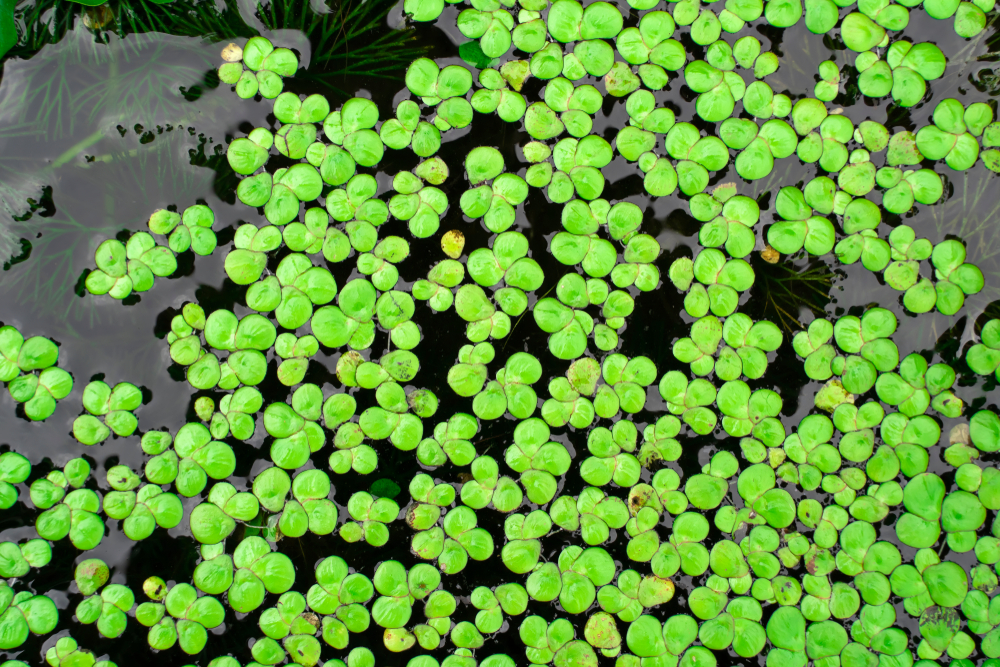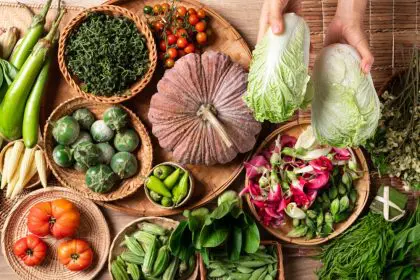What looks like green pond scum floating on water surfaces is quietly becoming the hottest ingredient in high-end restaurants and health food circles. Water lentils, better known as duckweed, are transforming from pond nuisance to culinary goldmine as chefs and nutritionists discovery this tiny aquatic plant packs more protein per acre than soybeans and grows faster than any other known food crop.
This isn’t just another trendy superfood that will disappear next season. Water lentils represent a genuine agricultural revolution that could help solve global food security problems while providing consumers with one of the most nutritionally dense foods ever discovered. The fact that it tastes surprisingly good is just a bonus that’s helping drive mainstream adoption.
The transformation of duckweed from pond pest to gourmet ingredient represents one of the most dramatic food stories in recent memory, with implications that extend far beyond restaurant menus to questions about sustainable agriculture, climate change, and feeding a growing global population.
This aquatic plant produces impossible amounts of protein
Water lentils contain up to 45 percent protein by dry weight, making them one of the richest plant-based protein sources on Earth. To put this in perspective, soybeans contain about 35 percent protein, while most other plant proteins hover around 20 to 25 percent. This protein isn’t just abundant – it’s complete, containing all nine essential amino acids that human bodies can’t produce on their own.
The protein quality in water lentils rivals that of animal products, with an amino acid profile that’s remarkably similar to eggs. This makes duckweed one of the few plant foods that can serve as a complete protein replacement for meat, dairy, and eggs without requiring combining with other proteins to achieve nutritional completeness.
Unlike many plant proteins that can be difficult to digest, water lentil protein is highly bioavailable, meaning your body can easily absorb and utilize the amino acids. This digestibility factor makes the already impressive protein content even more valuable from a nutritional standpoint.
The concentration of protein in such a small plant means that tiny amounts of processed water lentils can provide significant protein boosts to meals without dramatically changing taste or texture. This protein density is what’s making food manufacturers excited about incorporating duckweed into everything from protein bars to pasta.
Growth rates that defy agricultural logic
Water lentils reproduce so rapidly that they can double their biomass in just 16 to 48 hours under optimal conditions. This explosive growth rate means that a small pond can produce more protein per square foot than traditional agricultural land dedicated to any other crop, including the most efficient legumes and grains.
A single acre of water lentils can produce 10 times more protein than an acre of soybeans and 25 times more protein than an acre of corn. These numbers aren’t theoretical – they’re being achieved in commercial cultivation facilities that are scaling up production to meet growing demand from food manufacturers and restaurants.
The plants require no soil, no pesticides, no herbicides, and minimal fertilizer inputs compared to traditional crops. They grow in simple water systems that can be established on marginal land that’s unsuitable for conventional agriculture, making them a solution for expanding food production without competing for existing farmland.
Harvesting can occur continuously throughout the growing season rather than waiting for specific harvest times like traditional crops. This continuous harvest capability means that production can be optimized for demand and supply chains, reducing waste and improving efficiency.
Nutritional density goes beyond protein
While protein gets most of the attention, water lentils are nutritional powerhouses that provide impressive amounts of vitamins, minerals, and other beneficial compounds. They contain higher levels of vitamin A than carrots, more iron than spinach, and significant amounts of vitamin B12, which is typically found only in animal products.
The omega-3 fatty acid content in water lentils rivals that of fish, making them one of the few plant sources of these essential fats that are crucial for brain health and cardiovascular function. This combination of complete protein and omega-3s in a single plant source is virtually unheard of in the plant kingdom.
Antioxidant levels in water lentils are comparable to those found in blueberries and other superfruit, providing anti-inflammatory benefits that may help reduce chronic disease risk. The antioxidant profile includes unique compounds that aren’t commonly found in terrestrial plants.
Fiber content is substantial but not overwhelming, providing digestive benefits without the gastric distress that some high-fiber foods can cause. The fiber type found in water lentils appears to support beneficial gut bacteria growth, potentially providing additional health benefits beyond basic nutrition.
Culinary applications surprise professional chefs
The flavor profile of water lentils is surprisingly neutral and pleasant, with subtle vegetal notes that complement rather than compete with other ingredients. This mild taste makes them incredibly versatile for culinary applications, from protein-rich smoothies to sophisticated restaurant preparations.
When dried and powdered, water lentils can be incorporated into baked goods, pasta, and protein bars without significantly altering taste or texture while dramatically boosting nutritional content. The powder form allows for easy integration into existing recipes and manufacturing processes.
Fresh water lentils have a texture similar to baby spinach but with a slightly more substantial bite, making them suitable for salads, stir-fries, and other preparations where leafy greens are typically used. The texture holds up well to cooking, unlike some delicate aquatic plants.
High-end restaurants are experimenting with water lentil preparations that showcase the plant’s unique properties, from water lentil pesto to protein-rich soups and even innovative fermented preparations that develop complex umami flavors reminiscent of traditional fermented foods.
Environmental benefits reshape agriculture conversations
Water lentil cultivation requires 99 percent less water than traditional protein crops when measured per gram of protein produced. This water efficiency is achieved because the plants grow in water systems that can be recycled and reused, unlike field crops that require constant irrigation with fresh water.
The plants actually improve water quality as they grow by absorbing excess nitrogen and phosphorus that would otherwise contribute to water pollution. This means that water lentil farms can help remediate contaminated water sources while producing food, creating environmental benefits rather than environmental costs.
Carbon footprint calculations show that water lentil protein production generates significantly fewer greenhouse gas emissions than any animal protein and most plant proteins. The plants themselves absorb CO2 as they grow, and the production systems require minimal energy inputs compared to traditional agriculture.
Land use efficiency is so superior to traditional crops that widespread adoption of water lentils could potentially free up millions of acres of agricultural land for reforestation or carbon sequestration while actually increasing total protein production globally.
Commercial production scales rapidly
Food technology companies are investing hundreds of millions of dollars in water lentil cultivation facilities that can produce consistent, high-quality crops year-round regardless of weather conditions. These controlled environment systems can be established near urban centers, reducing transportation costs and improving supply chain reliability.
Automated harvesting and processing systems are being developed that can handle the unique requirements of water lentil production, from maintaining optimal growing conditions to processing the harvested plants into various food ingredients and consumer products.
Quality control systems ensure that commercially produced water lentils meet food safety standards and provide consistent nutritional profiles. These systems address concerns about aquatic plant cultivation and ensure that products meet the same safety standards as traditional agricultural products.
Supply chain partnerships with major food manufacturers and restaurant chains are driving scaled production investments. Companies are committing to purchase agreements that justify the infrastructure investments needed to bring water lentil production to commercial scale.
Consumer acceptance exceeds expectations
Taste tests and market research show surprisingly high consumer acceptance of water lentil-based products, even among consumers who are typically resistant to novel foods. The mild flavor and familiar textures help overcome the psychological barriers that often accompany new food ingredients.
Health-conscious consumers are particularly enthusiastic about water lentils once they understand the nutritional benefits. The combination of complete protein, omega-3 fatty acids, and environmental sustainability appeals to consumers who are looking for foods that align with their health and environmental values.
Restaurant applications are serving as important introduction points for consumers who might be hesitant to purchase water lentil products for home use. Positive dining experiences with expertly prepared water lentil dishes are building consumer confidence and familiarity with the ingredient.
Marketing efforts that focus on the sustainability and nutritional benefits rather than the novelty of the ingredient are proving most effective at driving consumer adoption. When positioned as a solution to environmental and health concerns rather than just another exotic food, consumer response is significantly more positive.
Regulatory approval paves the way for mainstream adoption
Food safety agencies in multiple countries have approved water lentils for human consumption, recognizing them as safe and nutritious food ingredients. These regulatory approvals clear the path for commercial food production and restaurant use without the legal barriers that sometimes slow novel food adoption.
Nutritional labeling guidelines treat water lentils as conventional vegetables, making it easy for food manufacturers to incorporate them into products without complex regulatory processes. This regulatory simplicity encourages experimentation and adoption by food companies.
Organic certification standards have been established for water lentil production, allowing certified organic products to appeal to consumers who prioritize organic foods. The cultivation methods used for water lentils align well with organic principles, making certification straightforward.
International trade regulations treat water lentils as conventional agricultural products, facilitating global trade and supply chain development. This regulatory framework supports the international expansion needed to scale production efficiently.
Investment capital flows into aquatic agriculture
Venture capital and agricultural investment funds are pouring money into water lentil cultivation companies, recognizing the potential for massive returns as demand for sustainable protein sources grows. This investment capital is accelerating technology development and production scaling.
Major food corporations are making strategic investments in water lentil companies to secure future supply chains for what they recognize as a transformative food ingredient. These corporate partnerships provide both capital and market access for emerging water lentil producers.
Government agricultural programs are beginning to include water lentil cultivation in sustainable agriculture initiatives, providing additional funding and support for farmers and companies interested in transitioning to aquatic crop production.
The investment momentum is creating a positive feedback loop where early successes attract additional capital, which funds further technology development and production scaling, which drives down costs and increases market adoption.
The future of food floats on water
Water lentils represent more than just another alternative protein – they’re a glimpse into a future where food production is decoupled from traditional agricultural limitations and aligned with environmental sustainability. As climate change and population growth put increasing pressure on global food systems, aquatic crops like water lentils offer solutions that seemed impossible just a few years ago.
The transformation from pond pest to restaurant staple demonstrates how quickly food systems can evolve when nutritional benefits, environmental advantages, and culinary potential align. What started as curiosity about an abundant aquatic plant has become a serious solution to some of the most pressing challenges facing global food security.
As production scales and costs decrease, water lentils are positioned to move from high-end restaurant menus to mainstream grocery stores, potentially transforming how we think about protein sources and sustainable food production for generations to come.













